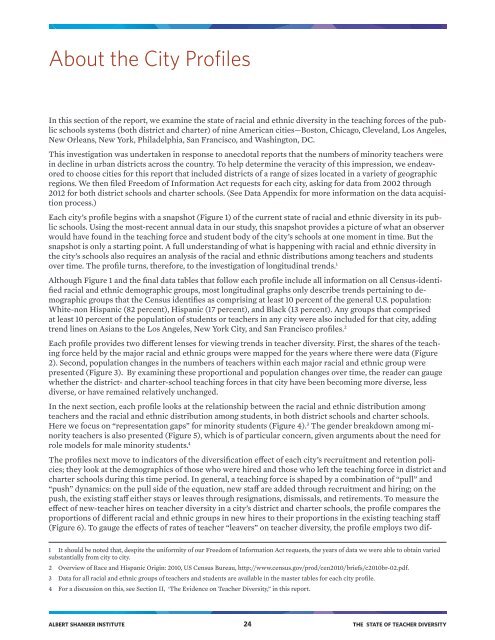TEACHER DIVERSITY
The State of Teacher Diversity_0
The State of Teacher Diversity_0
- No tags were found...
Create successful ePaper yourself
Turn your PDF publications into a flip-book with our unique Google optimized e-Paper software.
About the City Profiles<br />
In this section of the report, we examine the state of racial and ethnic diversity in the teaching forces of the public<br />
schools systems (both district and charter) of nine American cities—Boston, Chicago, Cleveland, Los Angeles,<br />
New Orleans, New York, Philadelphia, San Francisco, and Washington, DC.<br />
This investigation was undertaken in response to anecdotal reports that the numbers of minority teachers were<br />
in decline in urban districts across the country. To help determine the veracity of this impression, we endeavored<br />
to choose cities for this report that included districts of a range of sizes located in a variety of geographic<br />
regions. We then filed Freedom of Information Act requests for each city, asking for data from 2002 through<br />
2012 for both district schools and charter schools. (See Data Appendix for more information on the data acquisition<br />
process.)<br />
Each city’s profile begins with a snapshot (Figure 1) of the current state of racial and ethnic diversity in its public<br />
schools. Using the most-recent annual data in our study, this snapshot provides a picture of what an observer<br />
would have found in the teaching force and student body of the city’s schools at one moment in time. But the<br />
snapshot is only a starting point. A full understanding of what is happening with racial and ethnic diversity in<br />
the city’s schools also requires an analysis of the racial and ethnic distributions among teachers and students<br />
over time. The profile turns, therefore, to the investigation of longitudinal trends. 1<br />
Although Figure 1 and the final data tables that follow each profile include all information on all Census-identified<br />
racial and ethnic demographic groups, most longitudinal graphs only describe trends pertaining to demographic<br />
groups that the Census identifies as comprising at least 10 percent of the general U.S. population:<br />
White-non Hispanic (82 percent), Hispanic (17 percent), and Black (13 percent). Any groups that comprised<br />
at least 10 percent of the population of students or teachers in any city were also included for that city, adding<br />
trend lines on Asians to the Los Angeles, New York City, and San Francisco profiles. 2<br />
Each profile provides two different lenses for viewing trends in teacher diversity. First, the shares of the teaching<br />
force held by the major racial and ethnic groups were mapped for the years where there were data (Figure<br />
2). Second, population changes in the numbers of teachers within each major racial and ethnic group were<br />
presented (Figure 3). By examining these proportional and population changes over time, the reader can gauge<br />
whether the district- and charter-school teaching forces in that city have been becoming more diverse, less<br />
diverse, or have remained relatively unchanged.<br />
In the next section, each profile looks at the relationship between the racial and ethnic distribution among<br />
teachers and the racial and ethnic distribution among students, in both district schools and charter schools.<br />
Here we focus on “representation gaps” for minority students (Figure 4). 3 The gender breakdown among minority<br />
teachers is also presented (Figure 5), which is of particular concern, given arguments about the need for<br />
role models for male minority students. 4<br />
The profiles next move to indicators of the diversification effect of each city’s recruitment and retention policies;<br />
they look at the demographics of those who were hired and those who left the teaching force in district and<br />
charter schools during this time period. In general, a teaching force is shaped by a combination of “pull” and<br />
“push” dynamics: on the pull side of the equation, new staff are added through recruitment and hiring; on the<br />
push, the existing staff either stays or leaves through resignations, dismissals, and retirements. To measure the<br />
effect of new-teacher hires on teacher diversity in a city’s district and charter schools, the profile compares the<br />
proportions of different racial and ethnic groups in new hires to their proportions in the existing teaching staff<br />
(Figure 6). To gauge the effects of rates of teacher “leavers” on teacher diversity, the profile employs two dif-<br />
1 It should be noted that, despite the uniformity of our Freedom of Information Act requests, the years of data we were able to obtain varied<br />
substantially from city to city.<br />
2 Overview of Race and Hispanic Origin: 2010, US Census Bureau, http://www.census.gov/prod/cen2010/briefs/c2010br-02.pdf.<br />
3 Data for all racial and ethnic groups of teachers and students are available in the master tables for each city profile.<br />
4 For a discussion on this, see Section II, ‘The Evidence on Teacher Diversity,” in this report.<br />
ALBERT SHANKER INSTITUTE 24 THE STATE OF <strong>TEACHER</strong> <strong>DIVERSITY</strong>


